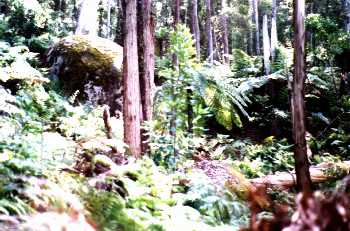Goolengook - The Story So Farwritten Sept 1999
On the eve of World Environment Day, June 4 1997, this
landscape was radically changed. The bulldozers and
chainsaws moved in despite the government
recommendations. Despite the Regional Forest Agreement
which was supposed to solve the forest debate. Despite a six
month blockade and thousands of people calling on the
government to save it. It had been our peaceful but well
fortified home. Quadpods and monopoles, tripods and
dragons, artwork and symbols, Goolengook road was
adorned with a collection of tarps, tents and blockade
structures. In the cities the Department and Minister’s
officers were the site of regular protest.
The department are busy carving up the entire area and access roads are scattered throughout Goolengook block to reach the heart of the forest and move closer to the boundaries of the National Park. This area is rapidly being destroyed, the fragile gullies exposed and the mountains laid bare. The river becomes silted. The forests become quieter, the abundance of wildlife, like the Sooty Owl and the Tiger Quoll, dissappear, their habitat destroyed forever. Bob Brown contested his case and the obstruction of forest operations charge was dismissed in the Moe Magistrate Court (27/2/98) on the grounds that the logging operation was not lawful. The government had ignored its own heritage rivers legislation and not provided an adequate buffer zone along the Goolengook River. The Department appealed the case and it went on to the Supreme Court where the original decision was upheld. The Department had been placing only 100 metre buffer zones along the heritage river zones across East Gippsland when it should have been 200 metres. This amounts to a huge amount of illegally logged rainforest. In the case of Goolengook, this includes rare overlap forest, where cool and warm temperate rainforests merge. For a week of direct action protests in old growth forests across East Gippsland in early March we needed only to turn up and the loggers would pack up and leave, apparently under instructions from Department officers. The police did not attend. It was obvious that the legality of logging all across the region was uncertain. In response the government simply brought in retrospective legislation to make the law fit the logging despite scientific advice on the protection of rivers and rainforests. Introduced at the same time were the new Forest Operation Zones. These are areas which effectively exclude the public and provide sole access to the forest for those who want to chop it down. Stumbling in to one such area without a permit could mean you are up for a $2000 fine. Since that time the blockade has continued at Goolengook. The area was re-fortified after last years logging. Protests have also occurred at two of the major woodchip mills in East Gippsland and across the border at Daishowa export woodchip mill in Eden. The mills send a lot of chips across the border but Daishowa also gets lots of truck loads of whole logs which are chipped on site. Goolengook blockade was again busted on 26 August 1998. The Department came in with the police and all the structures were knocked down but no-one was arrested. Unusually the loggers did not come in, the Department opened up new roads into the forest.
Finally after two years the Government dropped all charges against protesters arrested at Goolengook, conceding that we were right all along - unfortunately this victory was too late for the forest that has already been logged. During winter 1999 the blockade was removed due to an informal moratorium on logging for six months called by the DNRE while they assessed Potoroo zones. Surveying and scouting have continued over this time. At the start we said we will not stop until Goolengook is included in the National Park, the fact that we have lasted this long has the industry scared and we have definitely had an impact. And it is all set to continue.......... Update March 2000And continue it has - see the latest events Violent Pro-logging Mob Riot at Goolengook Bush Camp
|


